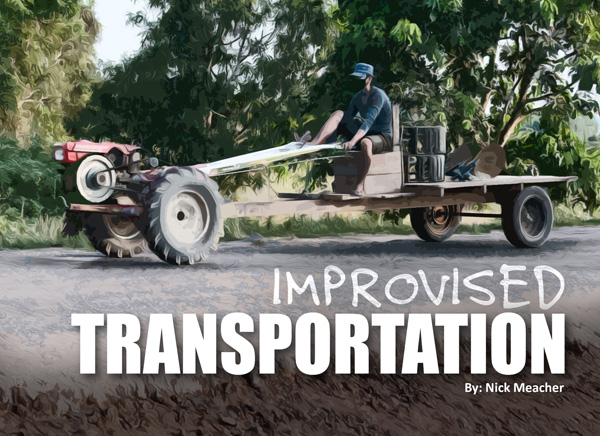If you had a Plan A, and B and C and you are now on Plan D, then you are probably at the point where you are doing a lot of improvising! “Opportunities multiply as they are seized.” – Sun Tsu
Being innovative is a skill that anyone involved in preparedness must cultivate. Some of this comes from a lot of reading, what did someone do in that situation? A big part of innovation is “thinking differently” or thinking outside of the box, using your imagination. Having an attitude of “that can’t be done” means that you give up before trying, you should think, “how can that be done?” You should have an attitude of “when it happens,” not “if it happens.”
The last thing you want to do is to walk carrying all your ‘stuff’ on your back. Remember, ounces equal pounds, and pounds equal pain. Having something to carry your ‘stuff’ in or on, and even better, to carry you is going to make your journey much easier.
In another article, we discussed “Plan B” modes of transportation, such as bikes, wagons, strollers, ATV’s, etc. In this article, we will suggest some improvised modes.
Wheeled modes are going to be one of the easiest improvised modes unless you are in the snow, and we will discuss that below. Wheels have been around since the caveman figured our rocks roll easier when they are round and smooth. A wheelbarrow can move loads easier; however, two wheels are easier to balance.
Adding a couple of small wheels on the rear legs means you can push or pull, rather than lift. If you take a walk through a hardware store or places like Tractor Supply, you will find all kinds of wheels for all types of wagons, wheelbarrows, trailers, etc. Add one or two to your supplies, and you will be able to convert or replace wheels on all kinds of things to make moving your ‘stuff’ easier. You can even add wheels to the bottom of a wooden pallet and tie/strap your stuff down or replace the stock wheels on a shopping cart with larger ones that will make it move a lot easier.
If you have something to pull your wagon/cart, then things are a lot easier. If the cart can take the weight, you can move heavier loads. A ride-on lawnmower, with the blades disengaged, can be used, or even a walk-behind powered mower can pull a smaller cart.
If you can’t find something with wheels then improvise a sled or a canoe, these will work well in snow but are going to take more effort to move on paved or round ground, but will still allow you to carry a load or an injured person. As mentioned above, a wooden pallet can be easily converted to a sled by removing parallel cross beams on either end. Kids snow sleds are another option. Again, if you have something motorized to pull, it will make it a lot easier to move. Lids from large bins, or plastic bins, can be used by attaching a rope to pull them, but be aware that the bottom will be worn through if pulled over rough or paved ground any distance. If you can find or improvise skis or something resembling skis, and you can put a cart or box on them.
Other options include an animal, such as a horse or donkey; however, this will require a harness if you are going to use them to pull a wagon, cart, or sled. Handling animals is also a skill, you just can’t walk into someone’s field and rope a horse! If the animal has never been used as a pack animal, harnessed, or used to pull something, then you are going to have a tough time ‘training’ it in an emergency. If you have a dog, then start training it to carry saddlebags (they make them for most sized dogs). The dog can then carry its own food, water, etc. It may not be a lot, but remember, it’s ounces and pounds that you don’t have to carry.
Final Thoughts
Avoiding pain and discomfort when trying to get home or bug out should be part of your goals, but you don’t want to dump your gear along the way. Improvising methods to move yourself, rather than walk, will shorten your journey back to your family. If you can’t do that, then finding ways to carry your load, or distribute the weight should be your next plan, especially over rough terrain or in severe weather such as snow. Look at what is around you all the time and ask yourself, “what if…” Some basic skills with some basic tools and some everyday parts can help you improvise something to make your trek more comfortable. Learn to “think differently” and “think outside the box.”
Remember: Fortune Favors the Prepared

